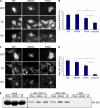The formin mDia2 stabilizes microtubules independently of its actin nucleation activity
- PMID: 18458159
- PMCID: PMC2364705
- DOI: 10.1083/jcb.200709029
The formin mDia2 stabilizes microtubules independently of its actin nucleation activity
Abstract
A critical microtubule (MT) polarization event in cell migration is the Rho/mDia-dependent stabilization of a subset of MTs oriented toward the direction of migration. Although mDia nucleates actin filaments, it is unclear whether this or a separate activity of mDia underlies MT stabilization. We generated two actin mutants (K853A and I704A) in a constitutively active version of mDia2 containing formin homology domains 1 and 2 (FH1FH2) and found that they still induced stable MTs and bound to the MT TIP proteins EB1 and APC, which have also been implicated in MT stabilization. A dimerization-impaired mutant of mDia2 (W630A) also generated stable MTs in cells. We examined whether FH1FH2mDia2 had direct activity on MTs in vitro and found that it bound directly to MTs, stabilized MTs against cold- and dilution-induced disassembly, and reduced the rates of growth and shortening during MT assembly and disassembly, respectively. These results indicate that mDia2 has a novel MT stabilization activity that is separate from its actin nucleation activity.
Figures







References
-
- Alberts, A.S. 2001. Identification of a carboxyl-terminal diaphanous-related formin homology protein autoregulatory domain. J. Biol. Chem. 276:2824–2830. - PubMed
-
- Copeland, J.W., S.J. Copeland, and R. Treisman. 2004. Homo-oligomerization is essential for F-actin assembly by the formin family FH2 domain. J. Biol. Chem. 279:50250–50256. - PubMed
Publication types
MeSH terms
Substances
Grants and funding
LinkOut - more resources
Full Text Sources
Molecular Biology Databases

